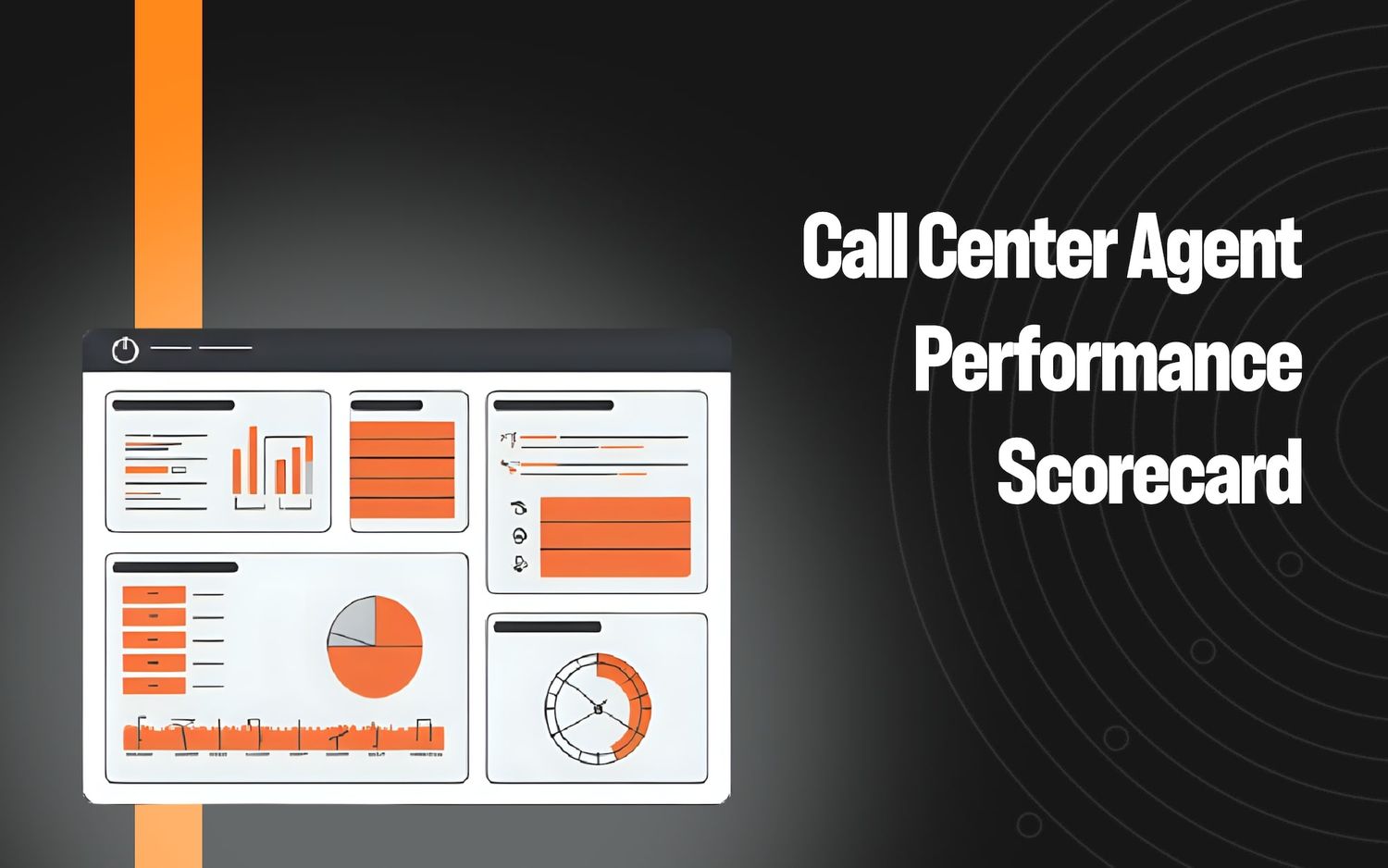9 Best Customer Experience Analytics Solutions

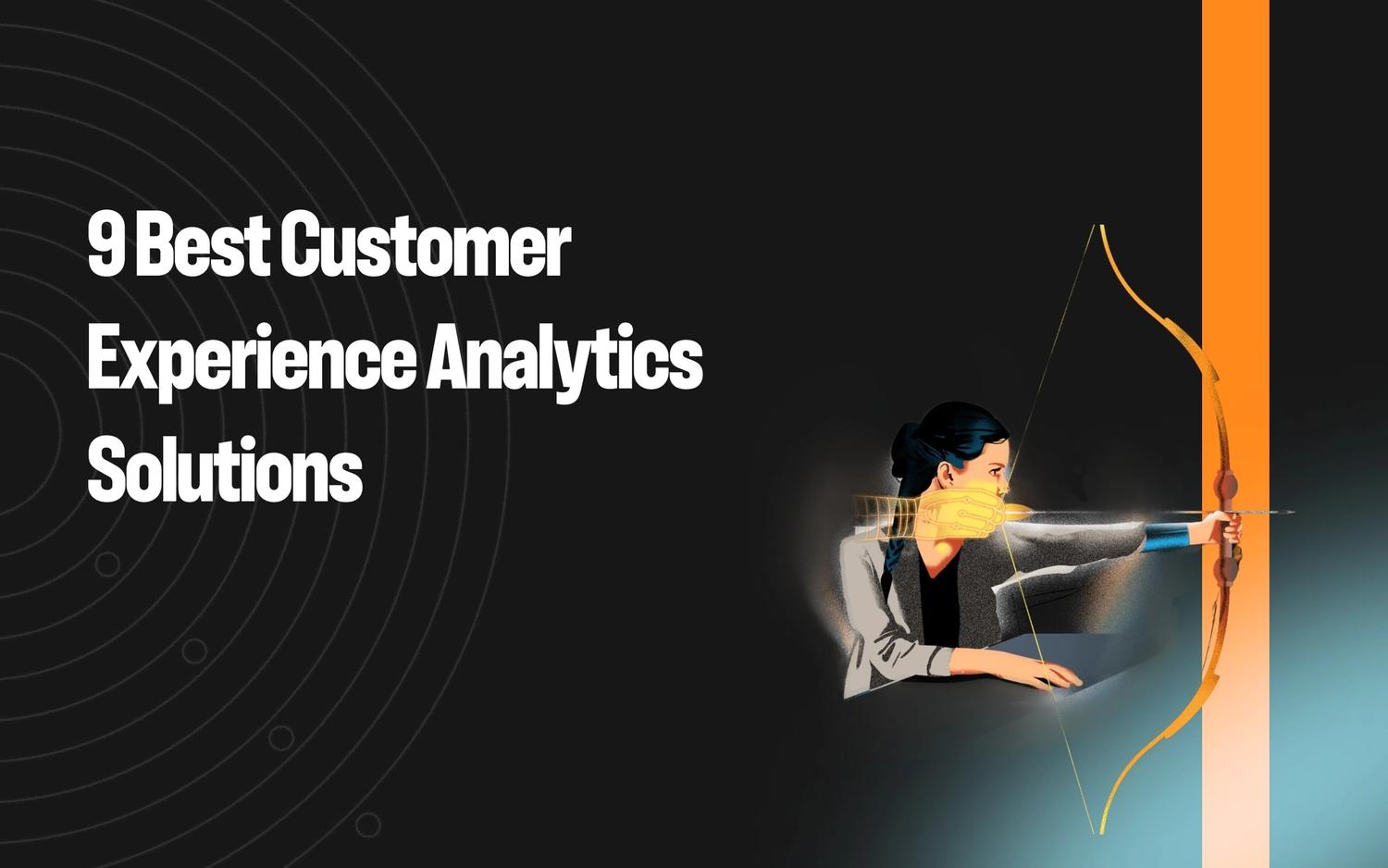
Customer experience (CX) analytics solutions include a variety of platforms that help improve the overall experience customers have with a product or company across different touchpoints and channels.
These platforms gather data on key interactions, from website clicks to calls with a customer service representative, and analyze each to extract valuable insights.
CX analytics solutions are typically used by:
- Customer success teams, who need to measure and improve customer satisfaction to increase customer loyalty and lifetime value.
- Product teams, who need to understand how customers are using the product and what can be done to increase adoption rates and product usage.
- Marketing teams, who need to identify and eliminate friction points that prevent prospects from converting into customers.
In this post, we’ll cover the ways in which product, marketing, and customer success teams can use CX analytics solutions to accomplish those goals.
Below, we present top CX solutions for each of the three teams, so feel free to skip to the section you’re interested in:
Customer Success Team Use Cases & How to Choose the Best Solution
Traditionally, QA teams manually review calls and other customer interactions to guide agent coaching and drive further improvements in CX.
However, QA teams that manually evaluate calls typically only randomly sample up to 2% of total calls. As the vast majority of conversations go unreviewed, teams may miss important patterns or recurring issues, leaving them without a complete picture of customer sentiments.
In contrast, modern CX analytics solutions allow you to gather and report on data from all customer interactions — in a fraction of the time — to give you a full picture of how your customers feel about your company.
That said, the quality of analysis that different solutions deliver can vary significantly.
Here are the three questions you need to consider when comparing different customer experience analytics solutions for customer support teams:
#1. Does the CX analytics solution accurately interpret customer intent?
Many modern solutions claim to use AI but in fact rely on rules-based algorithms, which don’t always interpret customer intent accurately.
For example, some tools use keyword matching to identify what customers and agents are saying without understanding the context or meaning of those words.
Such a solution trained to look for instances of the keyword “return” may correctly identify conversations mentioning either “I need to return this” or “I don’t want to return it,” while missing the meaning of conversations saying “I want to send it back.”
To capture as many such meanings as possible, administrators typically need to enter tens or even hundreds of combinations of keywords to signify a single intent (e.g., “I want to return this,” or “can I send it back”).
Even if an admin manages to enter all possible mentions of “Item Return,” a rule-based algorithm won’t necessarily detect the context or the “why” behind a customer’s intent.
Is the customer saying they need to return some outfits because they ordered multiple ones but want to keep the item they prefer? Or is it because the items didn’t fit or match the online description?
Another issue with using predefined algorithms is they may not detect sarcasm or irony, and (for example) count instances of a sarcastic “thank you” as a successful call outcome.
#2. Does it uncover trends you might not have known existed?
Most CX analytics solutions can analyze data across different communication channels. But another question is whether they also uncover trends that are less obvious.
An example would be a pain point affecting customer satisfaction that isn’t frequently explicitly expressed by customers, such as when they’re struggling to find information on the company website or trying to use a product due to a buggy feature release.
The solutions that lack advanced AI capabilities may miss these subtle patterns in complaints because they’re often limited to surface-level CX data analysis, such as predefined keyword matching.
These traditional methods can overlook complex patterns in customer behavior that don’t involve obvious keywords or phrases. In contrast, AI-enabled solutions analyze large volumes of unstructured data and recognize deeper trends through their ability to understand context and intent more dynamically.
This allows the ability to identify underlying issues, like customer frustration due to website navigation challenges or product usability issues, even when these concerns aren’t directly expressed by customers.
That said, detecting trends isn't just about using the right tools, but also about having a unified view of customer interactions. This is why it’s useful to choose a tool that allows CS and product teams to import the customer data that was previously siloed across different departments, tools, and platforms.Then, they can further explore emerging trends and address them through data-driven decisions.
#3. Does this solution provide in-call support for agents and managers?
A modern AI-powered tool should also offer in-call support as a feature, since the ability to recognize intent in real time enables managers and agents on calls to respond more effectively and create a smoother, more engaging customer experience.
In-call support may include showing prompts to agents to help them reduce time to resolution and improve customer satisfaction scores. It may also include call monitoring, supporting managers by showing them customer sentiment and other stats of live calls to give them the full context without needing to pull an agent out of a call.
An AI-powered CX analytics tool offering in-call support can also help standardize quality across interactions, ensuring consistent service levels and empowering agents to make informed decisions in real time.
Now that we’ve discussed the points you should consider in a CX analytics solution, here are the top three solutions for customer success and product teams:
Top 6 Customer Experience Analytics Solutions for Customer Success and Product Teams
Level AI: Understands what’s being said to improve customer interactions

Level AI is a CX analytics platform for QA and customer service and product teams that’s powered by secure, customizable generative AI capabilities.
It uses natural language understanding (NLU) and semantic intelligence to understand customers’ needs and wants by analyzing the underlying meanings of words with near-human accuracy.
This allows the platform to provide conversational intelligence, or insights into what’s driving customers to contact your organization.
The AI-powered capabilities not only provide comprehensive quality assurance across 100% of interactions but also allow teams to proactively improve customer experience by identifying patterns, spotting emerging trends, and providing actionable feedback in real time.
Below, we highlight key features of Level AI that drive customer satisfaction and operational excellence:
Intent Recognition and Sentiment Analysis
The platform’s Scenario Engine automatically detects intent in speech and classifies each particular intent as a scenario.
Examples of scenarios might be:
- Technical Support Request
- Billing and Payment Issue
- Upsell Opportunity
- Cancel Request
The system marks the occurrence of specific scenarios in recorded conversations with conversation tags, each representing a distinct scenario. These tags highlight the parts of a conversation transcript where a customer or agent expressed a particular intent.
By examining these tags, you can quickly see how a conversation progressed, as topics often shift from one theme to another.
Another useful feature of tags is they’re also searchable and filterable, and allow you to create lists of conversations containing a particular intent, such as where an agent mentioned they would follow up on an issue:

While most common tags and scenarios are already included in the tool, teams can also add their own scenarios and tags that are specific to their business.

The capability to discern intent in interactions is foundational to Level AI's conversational intelligence, enabling accurate sentiment analysis, automated scoring of agent performance, and actionable insights that drive improved customer experiences.
Another useful application of intent recognition is sentiment analysis. By understanding not only what customers are saying but also how they feel about it, Level AI captures subtle emotional cues — such as frustration, satisfaction, or worry — that provide a deeper layer of insight into the customer experience.
In fact, our platform identifies the widest range of sentiments of any platform in the industry:
- Anger
- Disapproval
- Disappointment
- Worry
- Happiness
- Admiration
- Gratitude
Level AI also scores the overall state and intensity of sentiments expressed during a call. Based on the sentiment detected, the system gives every conversation an overall score from 0 to 10, with 0 as strongly negative and 10 as strongly positive.
Sentiments at the end of the call are weighed more heavily, as they offer a more lasting impression of how a customer feels about the agent’s resolution of their problem.

Voice of the Customer Analytics for Uncovering Subtle Trends
While teams traditionally rely on post-interaction surveys to understand how customers evaluate their experience, Level AI automatically uncovers voice of the customer (VoC) data by analyzing customer statements and behaviors during their interactions with your organization.
Our VoC Insights provide not only standard metrics like CSAT, NPS, CES, and more, but also surface patterns in customer behavior, some of which may be subtle and not easily discerned.
Examples of such patterns include:
- Changes in the volume of customer queries about specific issues, like product quality complaints.
- Difficulties customers experience when deploying a new feature or finding information about it.
- Higher negative sentiment after changes in pricing policies.
- Recurring customer requests for specific feature enhancements or new capabilities.
- Spikes in customer frustration or confusion immediately following a product update or feature change.
Level AI presents voice of customer insights and customer analytics in an easy and intuitive dashboard:

Keeping track of emerging or recurring themes through VoC Insights can help customer success and product teams in four ways:
- They detect and prioritize external issues that need to be addressed to prevent customer churn; for example, confusing onboarding or UI.
- They identify inconsistencies in how agents resolve recurring issues that affect the company’s bottom line and result in lower customer satisfaction, so that CS teams can close those gaps through training.
- They find opportunities to improve customer experience during seasonal peaks in customer interactions, such as enabling self-service options.
- They uncover patterns in feature-related feedback, allowing product teams to prioritize updates or enhancements that align with customer needs and improve overall product adoption.
One of Level AI’s customers was able to save the equivalent of three agents’ workload by adding a self-serve cancellation flow to their website.
Comprehensive Customer Data Analysis and Custom Reporting for Actionable Insights
CS teams can also get a unified view of company-wide data — which can be hard to access due to organizational and tool silos, as well as disparate data and file formats — through Level AI’s API integrations with CRMs, knowledge bases, ticketing systems, survey tools and other data sources, allowing them to build tailored charts and dashboards in Level AI’s Query Builder.
This tool lets teams analyze trends and topics by merging external data sources with Level AI’s own data like conversation and sentiment tags to answer questions like:
- How do different communication channels compare in terms of customer satisfaction?
- What is the impact of training programs on agent performance metrics?
- What types of issues are resolved the fastest – and the slowest?
- Can sentiments expressed during a call predict the likelihood of a high customer satisfaction rating?
- What strategies or actions have allowed agents to effectively reverse negative customer sentiments?

Automatic Scoring of Contact Center Agent Performance Across Key Metrics
Level AI automatically scores agents’ performance and tags interactions that have opportunities for improvement, so that QA teams and managers can quickly identify coaching needs, accelerate feedback, and implement targeted action plans to elevate service quality across the organization.
InstaScore evaluates agents’ performance against company rubrics, for example, how well they greeted a customer or provided clear next steps for an issue resolution.
Expressed as a percentage, InstaScore lets you instantly see which agents performed well or underperformed during their conversation, and decide whether it makes sense to explore the details of this conversation further.
Below is an example of autoscored agent performance values for each interaction in a contact center:
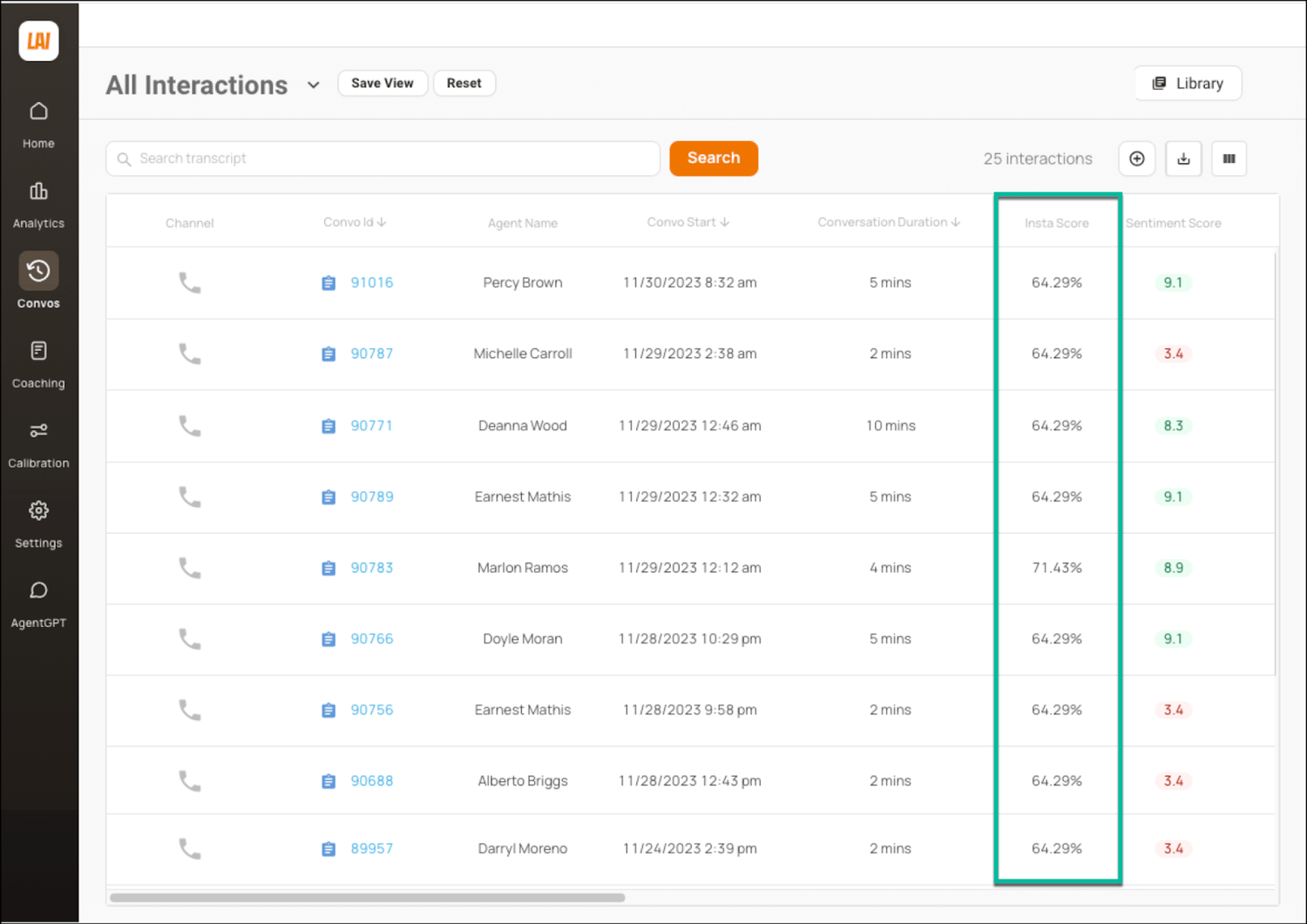
InstaReview is another feature that provides CS teams with at-a-glance insights into agent interactions to identify specific areas for immediate coaching and improvement, and automatically tags interactions that have negative aspects, such as:
- High number of requested assists
- Longer than average duration
- Low customer satisfaction based on the sentiment analysis score

Just as with InstaScore, InstaReview lets managers decide if it’s worth exploring a call further to better understand its issues and whether these align with broader trends uncovered through VoC analysis.
Real-time Support for Contact Center Agents and Managers
In addition to scoring conversations post-call, Level AI supports agents in real time to help resolve issues faster and allow them to stay focused on the conversation.
The two features that support agents in real time are Real-Time Agent Assist and AgentGPT (which, in addition to Real-Time Manager Assist, are all part of Level AI’s Agent Copilot).
Real-Time Agent Assist
Level AI’s NLU and semantic intelligence gives it the capability to recognize intent and topics under discussion in real time. This provides agents with contextual prompts and guidance to help them respond more effectively and resolve issues faster.
The main feed of Real-Time Agent Assist shows a number of knowledge cards, tips, and flags based entirely on the topics currently under discussion during the live call. These include:
- FAQs, action hints, and warnings
- Help cards originating from knowledge bases or other external systems
- AI-powered search (AgentGPT)

All cards in the feed contain feedback buttons (in the form of thumbs up and down buttons) enabling agents to up- or downvote the helpfulness and accuracy of the displayed information.
Displaying this information exactly where and when agents need it (thanks to Level AI’s ability to interpret intent and provide real-time guidance) allows agents to answer customer queries more productively and handle calls with greater confidence and efficiency.
One of Level AI's customers was able to reduce average handle times by 20% and increase First Call Resolution rates by 15% after introducing Real-Time Agent Assist.
AgentGPT
AgentGPT is a search functionality built within Real-Time Agent Assist that helps agents find the information they need faster, reducing their cognitive load and enabling them to focus more fully on the customer interaction for a smoother, more efficient service experience.
AgentGPT analyzes live conversations to understand what issue the customer has and suggests queries for quick selection by agents.
It also extracts the most relevant information from across all sources of knowledge so agents don’t have to read long articles, and offers a ChatGPT-like interface to ask follow-up questions.

Any of the displayed search results or summaries can be up- and downvoted to further improve AI suggestions.
Real-Time Manager Assist
Supervisors can monitor calls in real time to support agents more effectively without interrupting the flow of a call.
Real-Time Manager Assist shows live dashboards of ongoing conversations that reveal:
- Key stats like call duration and customer likelihood to convert
- Customer sentiment score
- Agent performance (InstaScore)
- Coachable Insights indicating salient features of the call like “Sales objection,” or “Agent uncertainty”
This gives managers instant insights into where and when they need to directly intervene in order to shore up a call that’s flagging or use call whispering to give the agent advice.

Managers can also click on any of the displayed metrics to see additional details, like the evidence underpinning a low agent InstaScore:

Explore Level AI CX Analytics Features for Customer Support Teams
Level AI provides 100% QA coverage of conversations for call centers, and offers valuable insights on how to improve each agent’s performance and improve CX overall.
Schedule a free demo to learn how Level AI empowers your CS team to deliver smarter, more efficient service and elevate the customer experience with real-time and advanced analytics.
Zendesk
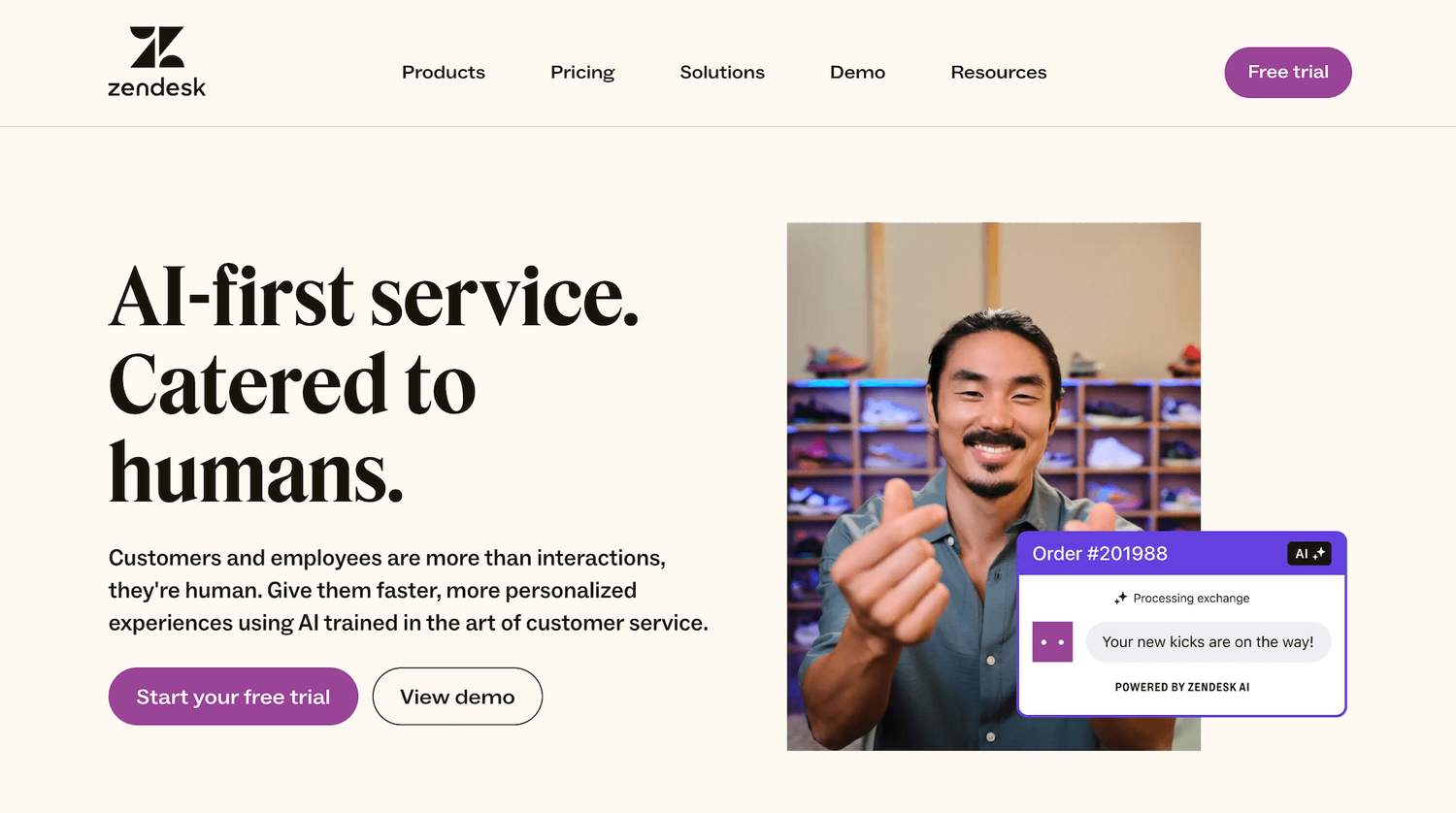
Zendesk is an omnichannel solution that helps CS teams provide faster, customized support to end customers. It lets agents improve their productivity, offer personalized conversations to customers, and access an integrated view of customer data on one platform.
Zendesk features include:
- Agent workspace
- Routing and ticketing
- AI agents and automation
- Analytics and reporting
- Workforce engagement management
- Quality assurance
- Marketplace for integrations, including apps for net promoter score and customer satisfaction scores
Zendesk offers a free trial with Zendesk Professional Plan features enabled by default. Zendesk plans start at $55 per agent per month for an out-of-the box solution and at $19 per month per user for email-support-only plans.
Talkdesk

Talkdesk is a CX platform that offers industry-specific CX solutions for financial services, healthcare, government and education, and retail. Talkdesk helps automate customer journey steps with applications for customer self-service, omnichannel engagement, customer experience analytics, and more.
Talkdesk features include:
- Voice and digital inquiries management and prioritization
- Call routing
- Workflow automations for agents
- Conversational AI and AI training
- Customer intelligence insight analysis
- Quality management
Talkdesk pricing starts at $85 per user per month. No free trial is available, but the company offers a series of product demos to help prospective users evaluate their product.
Amplitude

Amplitude is a digital analytics platform that helps optimize business value of digital products through combining website and product analytics capabilities, feature management, and experimentation features to track the customer journey.
Amplitude features include:
- Product and website analytics with customizable dashboards
- In-product feature experimentation for actionable insights on feature adoption
- Website A/B testing capabilities
- Feature management for real-time customer feedback
- Machine learning to find hidden patterns in data
Amplitude offers a free Starter plan for up to 50K MTUs as well as a free Growth plan for startups with under $10M in funding and fewer than 20 employees. Paid plans start at $49 monthly for an annual plan.
Fullstory
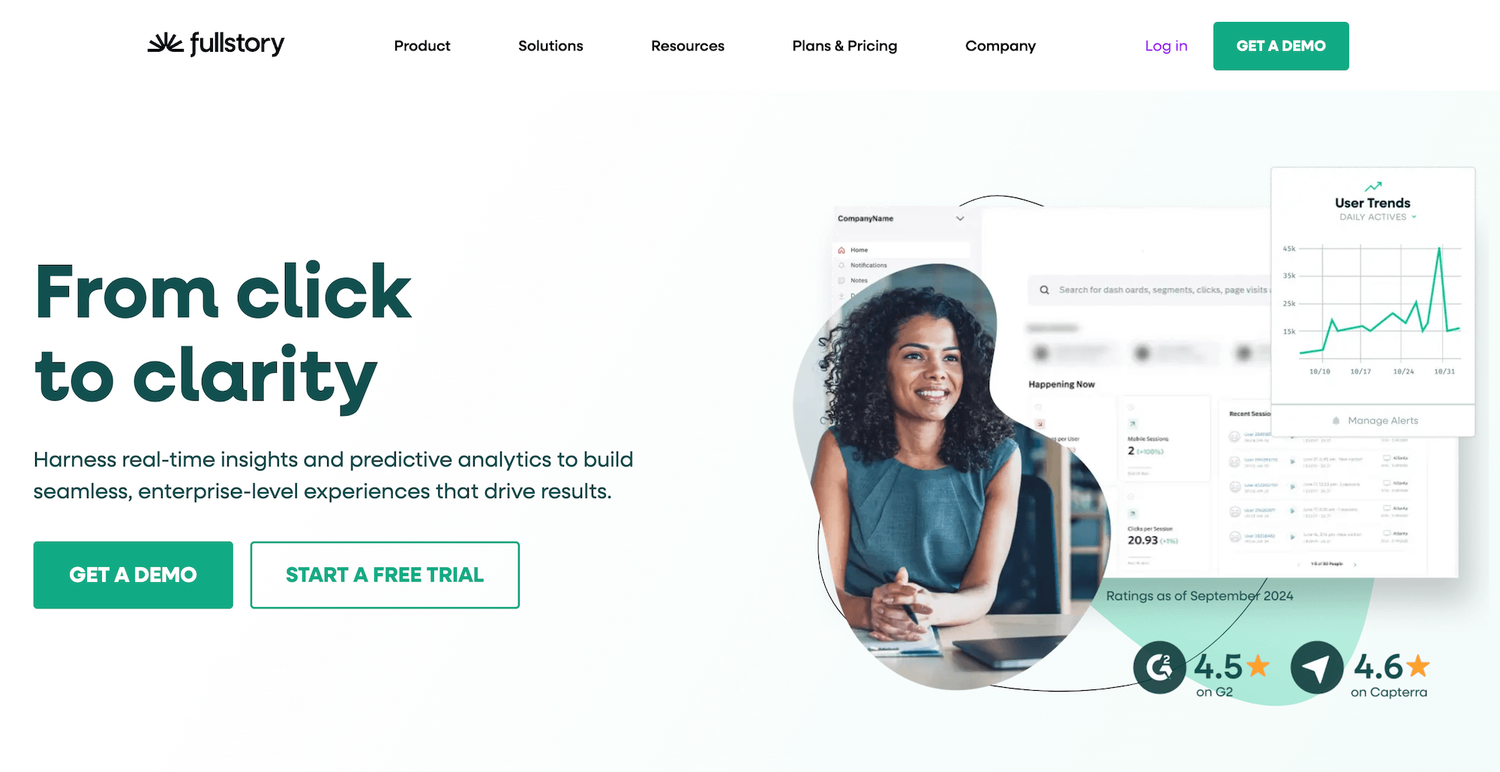
Fullstory helps understand customer behavior and optimize CX within digital environments, including funnel optimization and better experience design for the entire customer journey.
Fullstory features include:
- Automated data capture and notifications
- User interactions replays and heatmaps
- Integration with data warehouses for advanced analytics and customer feedback tools for customer insights
- Mobile app analytics
Fullstory offers a free plan and a two-week free trial of the Business plan that includes session insights and product analytics, as well as full data capture with their Fullcapture features.
No specific pricing information is available on their website.
Userpilot

Userpilot helps product teams improve customer experience by monitoring and analyzing in-app behavior so that they can optimize user onboarding, increase customer loyalty, find revenue expansion opportunities, and run more impactful product launches.
Userpilot features include:
- Funnel and in-product path analysis for onboarding and conversion rate optimization across key touchpoints
- Cohort analysis across user segments and features for better decision making around customer retention
- Data visualization dashboards for activation, product usage, and feature adoption
- In-app surveys for customer feedback, supporting behavioral triggers and segmentation
- In-app guides to improve CX, including tours, checklists, tooltips and banners for higher customer engagement
Userpilot plans start at $249 per month billed annually. The Starter plan is offered with a 14-day free trial.
Marketing Team Use Cases for CX Analytics Solutions and Top 3 Tools
For marketing teams, customer experience analytics tools will include features such as web traffic analytics, website visitor behavior analytics, and A/B testing, so that they can:
- Increase conversion rates across various channels
- Identify and remove friction points
- Personalize user experience
- Capture and address feedback to improve conversions
Keep reading to learn more about top customer experience analytics solutions for marketing teams.
Kissmetrics
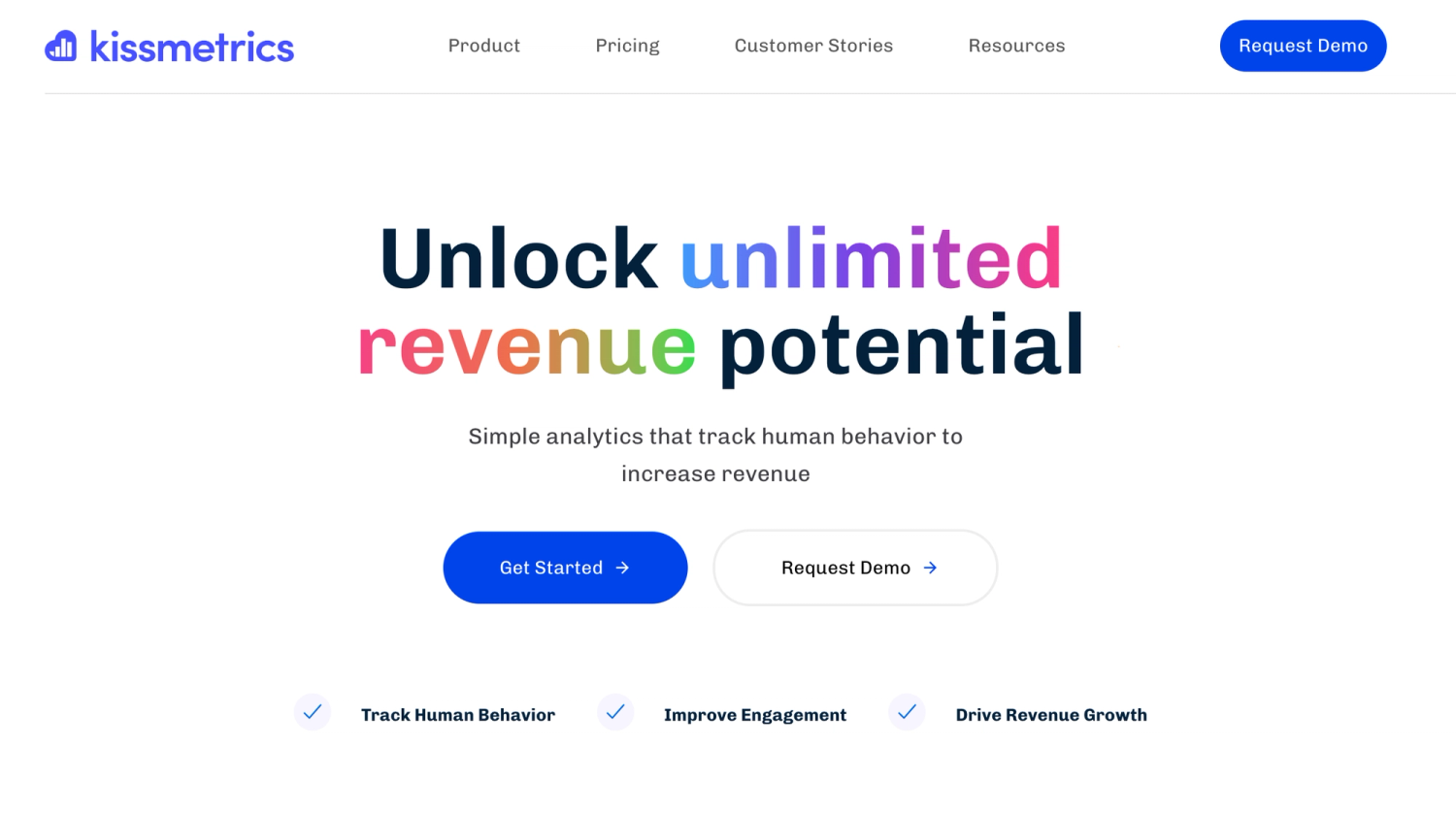
Kissmetrics is an analytics platform that tracks user behavior across all stages of the customer acquisition funnel, helping teams understand how visitors convert into trial users and then into paid customers.
Kissmetrics features include:
- Funnel tracking to identify drop-off points on the customer journey from visitor to trial user to paid user
- Tracking user behavior across acquisition sources and customer engagement in terms of feature usage
- KPI monitoring for customer churn, customer lifetime value and user counts across products
- Advanced business reporting with data integration capabilities
Kissmetrics plans start at $299 per month for annual plans, with an option to build your own limited plan for up to 1M events starting at $125.99 per month for monthly billing.
Hotjar
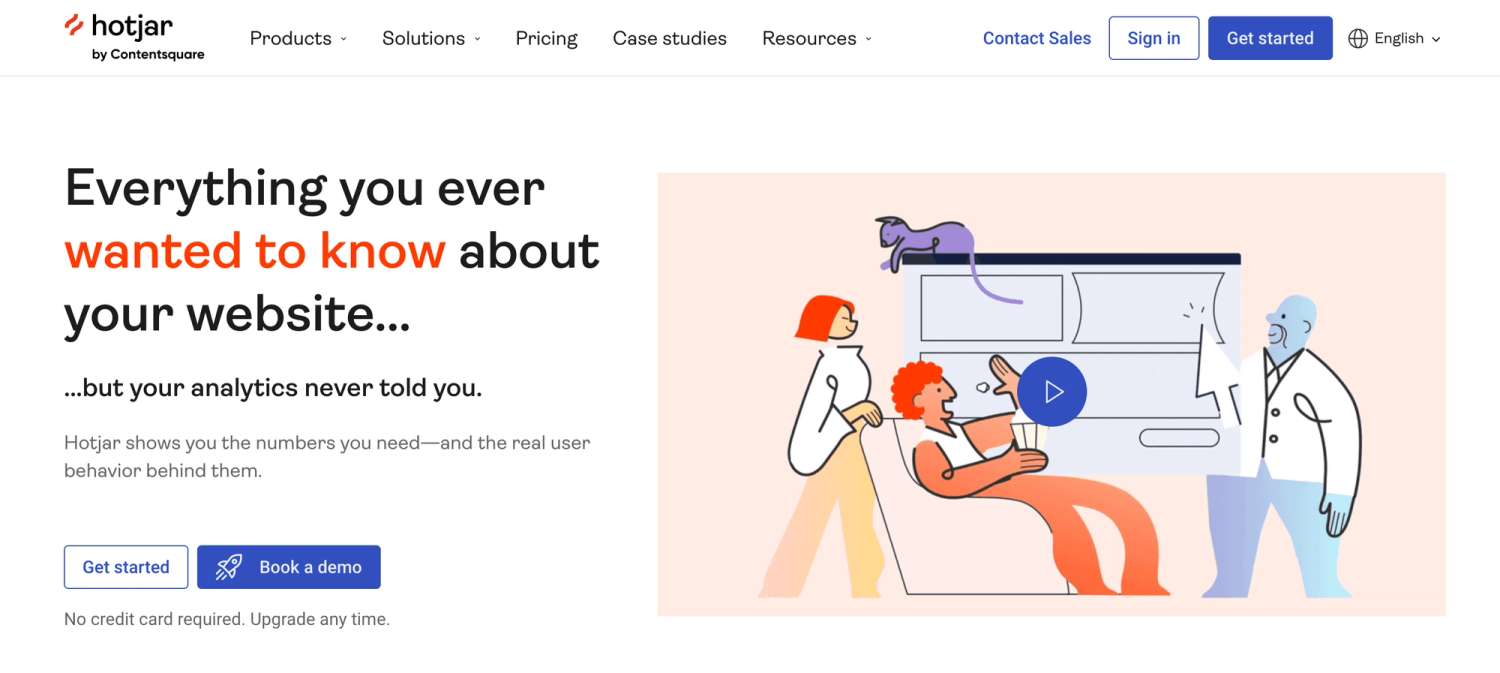
Hotjar helps teams complement website analytics data with real user behavior data, such as session recording and heatmaps, and get feedback on website designs, UX and copy.
Hotjar features include:
- Heatmaps and session recordings of user interactions
- Feedback widget and survey forms for website users
- Funnel analysis to identify conversion blockers
- Interviews for customer or user feedback on prototypes, designs, and test hypotheses around design or customer pain points
- Integrations to help automate data gathering and review
Hotjar’s Basic Plan is offered for free, with up to 35 daily sessions captured and HubSpot integration included. Their paid plans start at $32 per month for a yearly plan and allow users to capture up to 100 sessions (Plus Plan) or more for higher-tier plans.
Mixpanel

Mixpanel is a software that helps track user experience across the customer journey, merging website and product analytics data, so that marketing teams can continue tracking customer behavior in-app or inside a digital product.
It offers industry-specific solutions for healthcare, financial services, e-commerce, media and entertainment, and B2B SaaS.
Mixpanel features include:
- Behavior tracking across marketing channels, including session replay videos
- Dynamic funnel builders to track conversions and optimization opportunities
- KPI monitoring, such as CPC or ROAS, for paid marketing campaigns funnels and in-product metrics
Mixpanel offers a free plan with analytics essentials and up to 20 million monthly events included. Their paid plans start at $24 per month, with pricing increasing with the number of captured events.
Reach Out to Learn More About Level AI’s Customer Experience Analytics Solution
See how you can implement Level AI for 100% call coverage to uncover insights that improve customer satisfaction, enhance agent performance, and drive impactful business decisions.
Keep reading
View all

